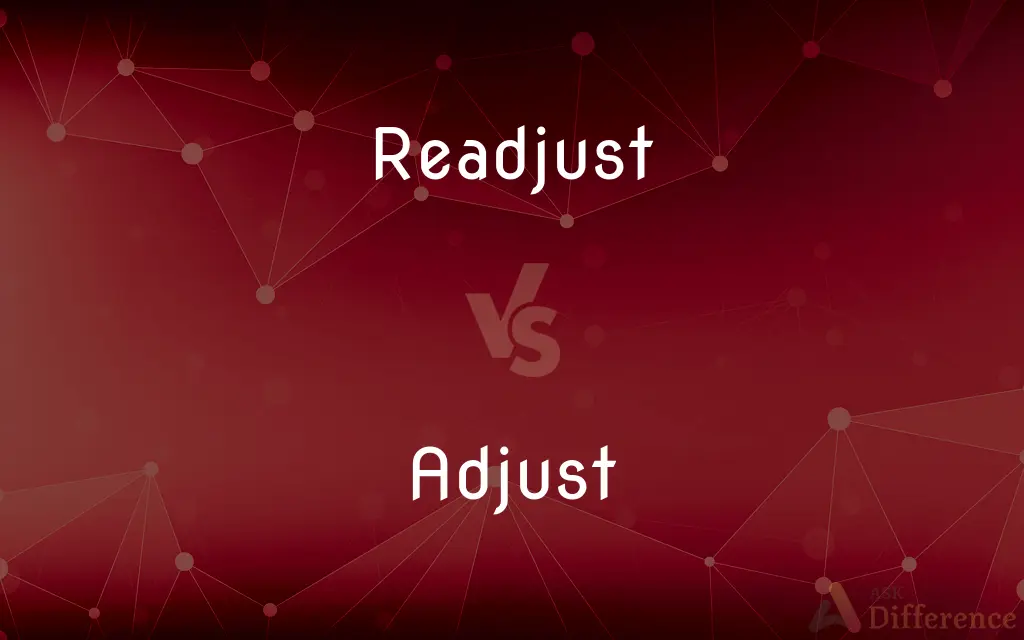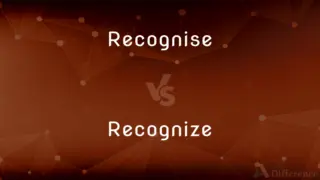Readjust vs. Adjust — What's the Difference?
By Maham Liaqat & Urooj Arif — Updated on March 29, 2024
Readjusting involves making minor changes to something already set or adjusted, focusing on refinement, whereas adjusting is about initially setting or adapting something to a specific condition or environment.

Difference Between Readjust and Adjust
Table of Contents
ADVERTISEMENT
Key Differences
When you readjust something, you're fine-tuning or modifying it after it has already been set or adjusted. This action often comes in response to new information or conditions that weren't apparent or didn't exist during the initial adjustment. On the other hand, adjusting is the process of initially setting or changing something to fit a new condition or environment. It's the first step in making sure something functions properly or fits into its surroundings.
Readjustment is generally a reactive process, implying a need to revisit and alter a previous decision or setting due to changes in circumstances or outcomes not being as expected. Whereas adjusting is proactive, involving the initial act of calibration or alignment to ensure compatibility or functionality from the outset.
The concept of readjusting often applies in situations where ongoing monitoring and refinement are necessary, such as readjusting the focus on a camera based on changing light conditions. Adjusting, however, is more about the act of setting up the camera's focus for the first time to suit the initial lighting.
In the context of personal development or psychology, readjustment can refer to the process of adapting oneself again to changed personal circumstances or recovering from a setback. Adjusting, in contrast, might be used to describe the initial process of adapting to a new environment, like moving to a new city.
Readjusting can be seen as a more specific and sometimes more frequent action, especially in environments or situations that are dynamic and subject to frequent changes. Adjusting, however, might happen less often, usually when there's a significant shift in conditions or when first encountering a new situation or environment.
ADVERTISEMENT
Comparison Chart
Definition
Modifying something already set or adjusted.
Setting or changing something to fit new conditions.
Nature
Reactive, based on refinement.
Proactive, based on initial setting.
Frequency
May occur more frequently in dynamic conditions.
Usually happens when first encountering a new situation.
Application
Often used in ongoing monitoring situations.
Used in initial setup or adaptation processes.
Context Example
Readjusting settings based on feedback.
Adjusting settings for the first setup.
Compare with Definitions
Readjust
To modify an existing setting.
She had to readjust the rearview mirror after someone else drove her car.
Adjust
To set something to a desired level or condition.
He adjusted the temperature in the room to be more comfortable.
Readjust
To refine a position or opinion.
He readjusted his stance on the issue after learning more about it.
Adjust
To adapt to a new environment.
She quickly adjusted to life in a new country.
Readjust
To alter a previous decision.
The team decided to readjust their strategy following new market research.
Adjust
To align something properly.
The engineer adjusted the machine for optimal performance.
Readjust
To adapt again to a change.
After moving back home, she had to readjust to her old lifestyle.
Adjust
To accommodate or make suitable.
The teacher adjusted the lesson plan based on the students' feedback.
Readjust
To correct or perfect something.
The photographer had to readjust the focus before taking the shot.
Adjust
To change something to fit.
They adjusted the budget to account for unexpected expenses.
Readjust
To adjust or arrange again.
Adjust
To move or change (something) so as to be in a more effective arrangement or desired condition
Adjust the timing of a car's engine.
Adjust a hearing aid to amplify lower frequencies.
Readjust
To adjust again.
Adjust
To change so as to be suitable to or conform with something else
Adjusted the schedule to allow for everyone's vacation plans.
Adjusted the old monetary figures to account for inflation.
Readjust
To adjust or settle again; to put in a different order or relation; to rearrange.
Adjust
In chiropractic medicine, to manipulate (the spine and other body structures) to treat disorders and restore normal function of the nervous system.
Readjust
Adjust anew;
After moving back to America, he had to readjust
Adjust
To decide how much is to be paid on (an insurance claim).
Readjust
Adjust again after an initial failure
Adjust
To become adapted or accustomed, as to a new situation
Have you adjusted to working with your new colleagues?.
Adjust
(transitive) To modify.
Morimoto's recipes are adjusted to suit the American palate.
Adjust
(transitive) To improve or rectify.
He adjusted his initial conclusion to reflect the new data.
Adjust
(transitive) To settle an insurance claim.
Adjust
(intransitive) To change to fit circumstances.
Most immigrants adjust quickly to a new community.
She waited for her eyes to adjust to the darkness.
Adjust
To make exact; to fit; to make correspondent or conformable; to bring into proper relations; as, to adjust a garment to the body, or things to a standard.
Adjust
To put in order; to regulate, or reduce to system.
Adjusting the orthography.
Adjust
To settle or bring to a satisfactory state, so that parties are agreed in the result; as, to adjust accounts; the differences are adjusted.
Adjust
To bring to a true relative position, as the parts of an instrument; to regulate for use; as, to adjust a telescope or microscope.
Adjust
Alter or regulate so as to achieve accuracy or conform to a standard;
Adjust the clock, please
Correct the alignment of the front wheels
Adjust
Place in a line or arrange so as to be parallel or straight;
Align the car with the curb
Align the sheets of paper on the table
Adjust
Adapt or conform oneself to new or different conditions;
We must adjust to the bad economic situation
Adjust
Make correspondent or conformable;
Adjust your eyes to the darkness
Adjust
Decide how much is to be paid on an insurance claim
Common Curiosities
Can you readjust without having adjusted something first?
No, readjusting implies that there has already been an initial adjustment.
What are common situations where you need to adjust?
Common situations include moving to a new environment, encountering new tasks, or facing changes in requirements.
What does it mean to readjust?
Readjusting means making minor changes to something that has already been set or adjusted to improve or refine it.
What does adjust mean?
Adjusting means setting or changing something for the first time to fit new conditions or requirements.
Is adjusting a one-time process?
Adjusting is typically done initially, but it may be followed by readjustments as conditions change.
Why is readjusting important?
Readjusting is crucial for maintaining or improving functionality, performance, or suitability as conditions change.
How often do you need to readjust something?
The frequency of readjustments depends on how often the conditions or requirements change.
Can both adjusting and readjusting apply to personal development?
Yes, both terms can apply, with adjusting referring to initial adaptations and readjusting to subsequent modifications.
How does readjusting affect performance?
Readjusting can enhance performance by refining settings or decisions based on new information or feedback.
How do you know when to readjust something?
Indications for readjustment include feedback, changed conditions, or not achieving the desired outcomes.
What's the difference between adjusting and calibrating?
Adjusting sets or changes something broadly, while calibrating involves precise adjustments for accuracy.
Is readjusting always necessary?
It depends on the situation; some settings or decisions may require readjustments due to evolving conditions.
Can adjusting be seen as planning?
Yes, adjusting can be part of planning, setting initial conditions or parameters for success.
How can readjusting be applied in technology?
In technology, readjusting often involves updating settings, algorithms, or systems to improve performance or efficiency based on new data or feedback.
Do the terms have different connotations in psychology?
In psychology, both terms refer to adaptation processes, with adjusting often related to initial adaptations and readjusting to subsequent ones.
Share Your Discovery

Previous Comparison
Recognise vs. Recognize
Next Comparison
Servant vs. MinionAuthor Spotlight
Written by
Maham LiaqatCo-written by
Urooj ArifUrooj is a skilled content writer at Ask Difference, known for her exceptional ability to simplify complex topics into engaging and informative content. With a passion for research and a flair for clear, concise writing, she consistently delivers articles that resonate with our diverse audience.
















































